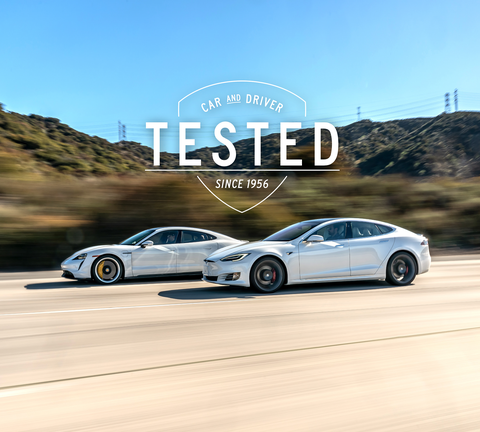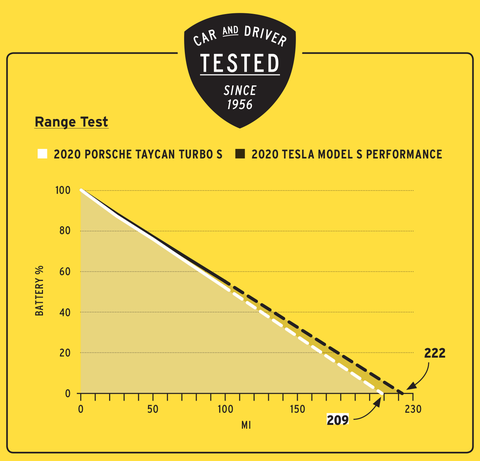
Marc UrbanoCar and Driver
- We’ve already published a comparison test between the Porsche Taycan Turbo S and the Tesla Model S Performance.
- Now we’re breaking down our test results to compare the two electric cars’ range numbers.
- We ran both cars at the same time on the same loop at 75 mph, and arrived at total range figures that were far closer than we expected.
When the Porsche Taycan’s first EPA range figure exposed itself to the public, the outcry was swift and decisive. Even those not strong in math might realize that a paltry 192-mile rating for the Taycan Turbo S is a huge miss compared with the 326- or 348-mile figures that the Tesla Model S Performance gets. It’s like coming out with a Toyota Prius competitor but, instead of getting 55 mpg, it got, say, 30 mpg instead.
So, as part of our comparison test between the two, a real-world test was in order, to get beyond the EPA’s dynamometers and prescribed cycles and see just how far behind the Porsche really is. It’s worth noting that our two test cars are the least efficient variants of each model line: the Taycan in top, Turbo S trim and wearing 21-inch Pirelli P Zero PZ4 tires, and the Model S Performance on 21-inch Michelin Pilot Sport 4Ss with the latest “Raven” upgrades to the suspension and new front electric motor.
Unfortunately, time and mileage constraints kept us from running the batteries as far down as we would have liked to, but the two cars were run on the same clear, 55-degree evening, at the same time, and around the same 6.5-mile oval at Hyundai’s California City, California, proving grounds. As is our typical practice, we set the automatic climate control in both cars to 72 degrees. With no elevation change and no traffic to get in the way, there are zero asterisks with the comparability of our results. We were contending with an 11-mph wind, however, which alternately hurt and helped as we made our 16 loops.
Both cars started fully charged at chargers adjacent to the oval, and we ran both cars at a GPS-verified 75 mph for a total of 100 miles, tracking each car’s state of battery charge, predicted range, and stated efficiency along the way. We also corrected for slight differences in odometer accuracy.
At the conclusion of our 100 miles, the Tesla was sitting at a 55 percent state of charge, and the Porsche was just behind at 52 percent. We then used the rate of battery depletion and range reduction—which, given our idealized test conditions, was extremely stable—to extrapolate out to a predicted total range figure.
The results were far closer than we expected: 209 miles for the Taycan, and 222 for the Model S.
Although that number might seem low for the Model S, it’s between our other Tesla highway-range results. The last Model S we tested, a 2018 100D, achieved 270 miles to a 335-mile EPA rating, and the first Model 3, a rear-drive Long Range, got 200 miles versus its 310-mile EPA figure at the time. That means at a steady 75 mph, the 100D achieved 81 percent of its EPA range, and the Model 3, 65 percent, while the figure for this latest Model S is 68 percent.
Of course, total range figures for electrics are always slightly fuzzy because an EV can’t run at highway speed all the way down to a zero state of charge. Along the way, it will go into a limp mode and limit speed in an attempt to delay your point of strandedness.
But this exercise was enough to convince us that the real-world range between the Taycan and the Model S won’t be significantly different. And, sure enough, both cars averaged an identical 70 MPGe, a figure that includes charging losses, over our three days of mixed (and pretty vigorous) driving.
Source: Reviews - aranddriver.com






